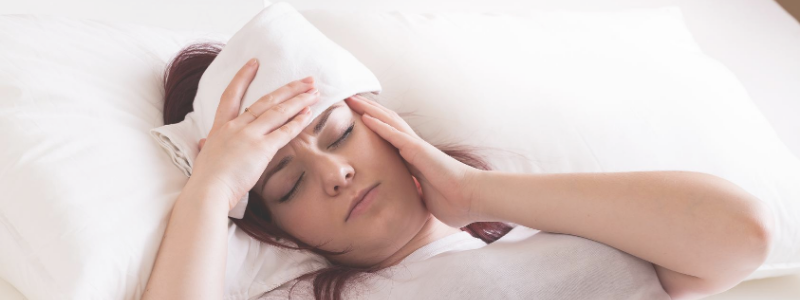
About half of Canadian adults suffer from headaches. For those of us who live in Southern Alberta, headaches can be more prevalent due to the barometric changes due to Chinooks.
While may of us suffer from headaches, you may think it's something you just have to learn to live with. But the first step is to identify the type of headache you are suffering from. Here are the 5 different types of headaches:
1. Cervicogenic Headache
This type of headache is caused by structures in the cervical spine. This is the part of your spine that starts at the base of your skull and ends at about the shoulders.
These headaches are usually made worse with certain neck movements or awkward postures, and the pain can radiate to the forehead, around the eyes, temples or ears. The pain is typically reproduced when the offending tissue, like muscles and joints, are pressed.
2. Cluster Headache
Most people know if they suffer from this severe, short, one-sided headache. They occur in clusters (hence the name) lasting anywhere from a week to a year. The period in-between clusters are pain free. They are chronic and can be difficult to treat.
Luckily, cluster headaches are less common, with 0.4% of men suffering, and 0.08% of women. The pain is characterized as sudden and severe, only on one side, with sweating, tearing and a running nose accompanying it. It is common for suffers to be constantly moving during an attack.
3. Migraine headache
There are two types of migraines; without aura (common), and with aura (classic). Most are classified as Migraine without aura.
Aura is a neurological symptom that proceeds the headache. Some people see lines, fuzzy spots, or shimmering, some feel like they’re in a fishbowl or have cotton in their ears. Auras vary from person to person and there is a very wide range of what can occur.
Women are more likely sufferers, with a 3:1 ratio. Most migraine sufferers know they have “triggers” which can range from certain foods, drinks, stress, medications or hormones.
Symptoms include one sided, throbbing type pain around the temple region, nausea, vomiting, light and sound sensitivity.
4. Tension headaches
Tension headaches come and go and have been described as a tightening or a vise around the head. There tends to be muscle pain and trigger points with this headache.
Outside of migraines, this is the next most common headache most doctors are seen for. Stress, lack of sleep, posture issues, jaw pain and diagnoses like depression can lead to these headaches.
5. Pathologic headache
These are emergency headaches that could mean a potentially life-threatening cause. Just 0.5% of headaches fall in this category, with causes ranging from infection, to tumor, to a stroke.
Some signs we look for to screen for these include abrupt onset, new headache in an older patient, changes in cognition, seizures, vomiting with no nausea, persistent headache in a child, known cancer and others. These are immediately referred to a medical doctor, either your GP in their office or an urgent care/emergency room visit.

Available Treatments for Headache Pain
While there are different reasons you may suffer from headache pain, preventive care and reducing symptoms during a headache can significantly help.
For some headache types such as hormonal migraines, barometric (chinook) headaches, or cluster headaches, changing the cause may not be easily done. However, even when that is the case, symptoms may be reduced with regular care.
For others where the main cause CAN be changed, headaches may be significantly reduced or eliminated. Treatment options will depend on what you are looking for and your underlying issues.
Chiropractic: adjustments, soft tissue work/release, cupping, IFC and exercises can all help with headaches. Getting to the core of your concern and addressing it will play a role in which of the techniques get used.
Massage: If the headache is caused by muscle tension, postural imbalances or stress, a massage can be an important part of your treatment plan.
Acupuncture: Most headaches can be helped by acupuncture, not just by directly addressing muscular issues, but also things such as inflammation.
Hypnosis/Guided Imagery: If stress is a big contributor, learning tools to manage stress may help reduce how often or how intense your headaches are.
Nutrition: If there is a dietary issue, which is typical of migraines, a nutrition consultation could help you narrow down triggers.
Rehabilitative Exercises: Stretching and strengthen helps reduce or eliminate any imbalances that may be straining the system, leading to a nonideal posture.
Osteopathy: Migraine or tension headaches can be improved with a cranial sacral treatment, as part of a manual osteopathic treatment. It’s a gentle hands-on treatment that releases compression and improves the flow of the cerebral spinal fluids.
Let us help Manage your Headache Pain
Movement Performance & Health offers a wide range of therapeutic treatments to help you cope with headache pain, tailored to your needs.
Contact us if you are seeking recommendations for treatment options or if you have specific questions about a treatment to address your headache pain. Email us at .
Sources
Canadian Headache Society https://headachesociety.ca
Orthopedic Conditions, Dr. Nikita A. Vizniak
ABOUT MPH
HOURS OF OPERATION
Mon: 7AM - 7PMTues: 7AM - 7PM
Wed: 7AM - 8PM
Thurs: 7AM - 7PM
Fri: 7AM - 5PM
Sat: 7AM - 2PM
Sun: 10AM - 3PM
Copyright © 2023 Movement Performance & Health. All rights reserved.

